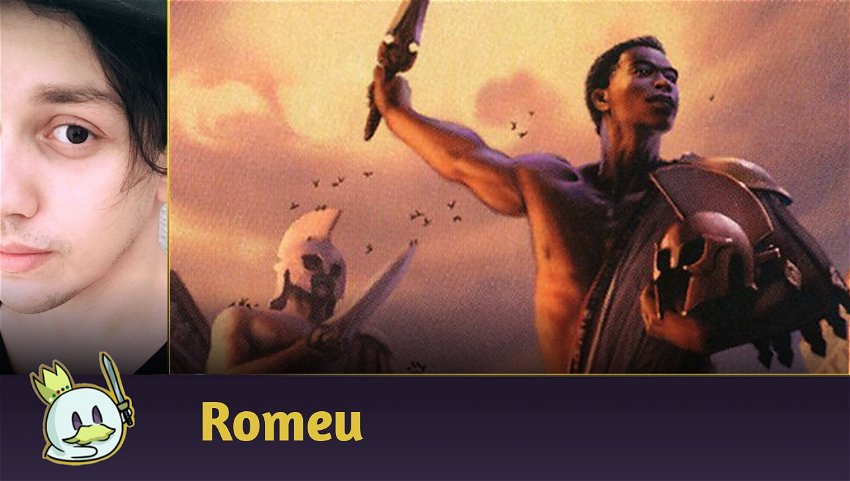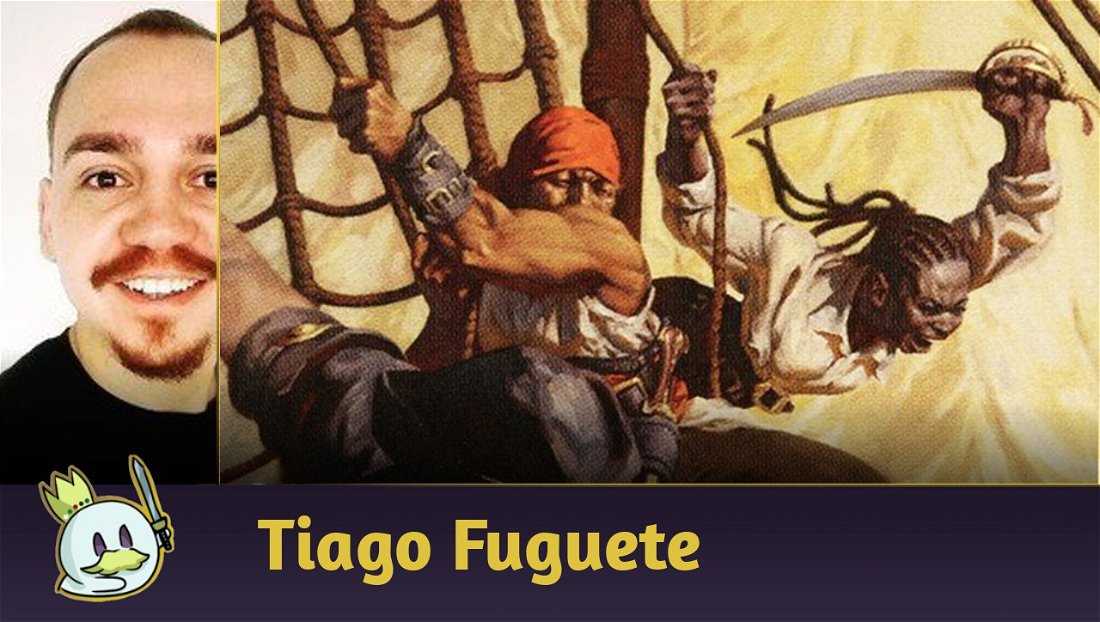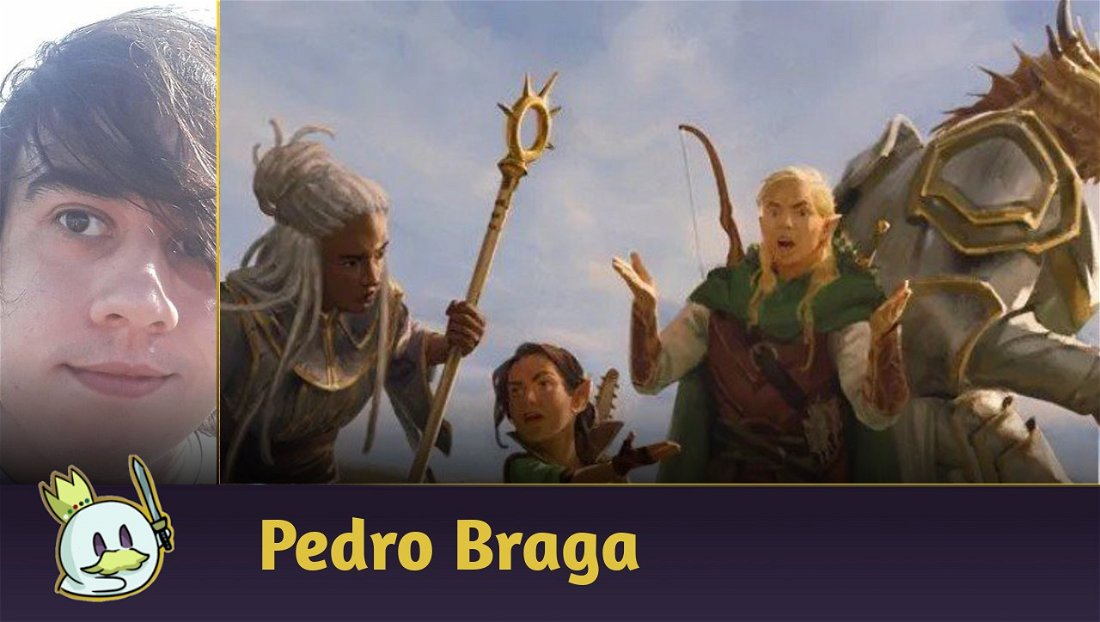Today's list is another one of the strategies that received a little boost with the launch of the first Explorer Anthology, thanks to the arrival of one of the biggest enablers of what we may call "voltron" available on Pioneer:

Favored Hoplite has always been at the heart of strategies aimed at making your creatures grow or gain wonderful abilities as it's the perfect target: it's a one-drop which ability allows various combat-related tricks, or protects it from damage-based removals, and it increases its own power even if you need to resort to a reactive spell to protect it, in addition to being an uncommon, significantly reducing the investment required in Magic Arena.
Therefore, today I'll introduce another budget list to the digital platform, exclusively focused on Best of One games, as I believe that this strategy can succeed much more in catching opponents off guard than in post-sideboard games, with different means of getting the famous "free-win button" and forcing your opponent to play around what you do and stay in a constantly reactive position: Mono White Heroic.
The Decklist
The strategy here is as simple and straightforward as you can imagine: play a creature, hope it survives, and from there, start playing spells to increase its power while having protective effects as a backup until the moment you can deal lethal damage to the opponent. However, it's not so simple that you only need to play spells and attack each turn - it requires some planning to sequence your spells the right way, but I'll elaborate on this point a bit later on.
I emphasize here that I don't believe this list (or Heroic's strategy in general) has what it takes today to compete well in the Best of Three environment, as its game plan is too linear, and its overall strategy is counter-interactive when compared to the main Metagame competitors like Rakdos Midrange or Mono Blue Spirits, opening up the opportunity for any opponent to adapt to what you're doing in Games 2 and 3 while you don't have the same flexibility, especially in a Mono-White version.
Finally, it is important to remember that this is a budget list, and it can be improved, as we will see later. It can certainly get you up to high Gold and Platinum ranked levels, but it also has inherent weaknesses that can get in the way of reaching Mythic or going well in a tournament.
Maindeck

A list whose strategy is to cast spells on its creatures is not viable without good payoffs.
Favored Hoplite is basically what made this deck possible, as you no longer need to rely on sub-optimized options like Monk of the Open Hand or a two-drop, giving much-needed consistency at having a threat in play as early as turn 1, while also attracting opposing removals and making room for more relevant threats.
Clever Lumimancer is another good one-drop and one of our free-win buttons at various stages of the game, as it triggers with any spell we cast and easily grows to disproportionate levels from turn 3 or 4.
However, our main wincodition and "free-win button" is Illuminator Virtuoso, which offers an insane clock, built-in power boost for every spell you target it, and a super powerful hand filtering that takes care of useless pieces, or interacts with spells you don't mind having in your graveyard, such as Homestead Courage.
Normally, untapping with an Illuminator Virtuoso can easily mean winning the game in a turn or two.

We also have two other complementary threats to close our creature base.
Faerie Guidemother works as a spell that gives evasion and power boost to your creatures, while also working as a decent threat to your pump spells since it has Flying.
Clarion Spirit was one of the creatures I used as a playset before Explorer Anthology came out, and it offers the opportunity to have a "go wide" plan in a mostly "go big" strategy.
Our deck has no problem triggering its abilities for repeated turns, but its number has been reduced since, with Favored Hoplite, we get more benefit from mixing proactive and reactive plays, while Clarion Spirit relies almost exclusively on being proactive.

Guiding Voice, in addition to triggering Magecraft and Heroic of our creatures, also offers us a flexible Lessonboard and seeks to meet our demands for every occasion.

Each of our Lessons meets a different need in the game: Environmental Sciences grants a land drop, Expanded Anatomy works as a second power boost in the same turn, Introduction to Prophecy gives us some card selection, Reduce to Memory can deal with problematic permanents, and Inkling Summoning gives us another body with evasion — and if none of those cards are what you need at the moment, you can always discard a useless card to draw another card.

Our other power boosts also have additional effects, with Defiant Strike serving as a draw while Homestead Courage, in addition to interacting with Illuminator Virtuoso, also triggers Heroic or Magecraft twice with a single card.

We must expect our opponents to manage to interact with our creatures, so we dedicate several slots to spells that can protect them from the most diverse situations.
Fight as One, in addition to providing a temporary power boost, is our main protection against sweepers while also being a useful option in the face of a Fatal Push or any other effect that would destroy our creatures.
On the other hand, Gods Willing and Sejiri Shelter offer both protection against removals and provides evasion to our threats at times when we need to be aggressive, often times we hold them in our hand to deal lethal damage on later turns.
In addition, Sejiri Shelter also works as a land, totaling 22 lands in the list, which helps us to always have a land drop in the initial turns and the possibility of mitigating the flood with more useful effects, or through Connive with Illuminator Virtuoso.
Alternate Card Choices

I like the idea of running Feat of Resistance as it offers protection and permanent power-up in a single card, and you can try it in place of Guiding Voice if you prefer, but that increases the mana requirements for a lethal attack.

Another option is to add Cartouche of Solidarity instead of Guiding Voice, replacing the Lessonboard with more creatures in play, but it doesn't interact with Magecraft.

You can exchange Clarion Spirit and even Faerie Guidemother for Leonin Lightscribe and Mavinda, Students' Advocate if you have them available. I didn't add them to the list merely because it would shy away from the proposal of a budget list with zero rare or mythic cards.

Speaking of rares, maybe a version with Auras instead of Instants and Sorceries could be an alternative for this deck to take advantage of Sram, Senior Edificer and Light-Paws, Emperor's Voice, but the absence of Ethereal Armor and the need to give up Clever Lumimancer seems to make this version less explosive, and Auras interact poorly with Gods Willing in case I must protect my creature from a Portable Hole or Fateful Absence.
Mulligan and Postures
Mulligan

What you need to have a good game plan against most opponents are: two creatures, two lands, a proactive pump, and a protection spell. The rest will come naturally as the game develops.
I like having the second creature as I always believe that one of my drops will be killed with a removal in the first few turns and/or removed with Thoughtseize, so I prioritize having a backup in case my starting hand only comes with one creature, to avoid not drawing a second threat later on.
However, this is a list you can't mulligan too much: the ideal minimum is 5, and any number below that greatly compromises your game plan. So, if you've given the first Mulligan and still don't have two threats and two lands, consider whether you have the wherewithal to interact with the game long enough to draw what you need within one to three turns.
For example, if I'm on the play and my hand has Favored Hoplite, Gods Willing, Illuminator Virtuoso and only one land, I can risk the keep because I can protect Favored Hoplite if the opponent doesn't kill it on turn 1.
On the other hand, any hand with more than three lands (unless one of them is Sejiri Shelter) will normally be a Mulligan, and obviously, any hand that doesn't have a payoff is an automatic Mulligan.
Postures
While you need to be proactive with Mono White Heroic, this deck actually takes a lot more planning and guesswork than it initially appears, as a wrong micro-interaction or faulty damage count could spell defeat in the following turn.
Basically, from the moment you play your creature, you must consider how your opponent might interact with it, or even delay the cast of some major threat like Illuminator Virtuoso by one turn to guarantee a means to protect it with Gods Willing or Fight as One on the next turn.
At the same time, we can't give the opponent too much time to stabilize because every creature on their board or extra untapped mana and additional draw phase means another opportunity for them to respond to what we have at stake, what we plan to do, or worse, pressure us to the point where we need to use our creatures as blockers.
That is, despite the simple proposal, playing Heroic requires a lot of knowledge of what people are playing to know what exactly you need to play around. Even a deck like Mono-Green Aggro can surprise you with a Primal Might to kill your creature if you're not careful, so having broad knowledge of the cards available in the format is necessary.
On the other hand, it's not humanly possible to play around everything while you press your opponent — you'll lack a fast clock and, as mentioned above, you don't want to waste too much time — so you'll occasionally need to make some bold and riskier moves to pressure your opponent, especially when untapping with Illuminator Virtuoso, and the best solution I've found to define whether I should take a risk is to ask myself if I can still win the game if this plan goes wrong - if the answer is "no", so I need to reconsider and evaluate another route where I apply pressure without exposing myself too much.
Tips and Tricks
> A Faerie Guidemother on turn 1 can be pretty decent as an initial threat if you want to preserve another one-drop for a later turn with protection backup
> Remember that once you give protection from white with Gods Willing or Sejiri Shelter, you can no longer cast spells on that creature. If you have to protect it from a Fateful Absence or other Instant-Speed removal, cast everything you need on it first before giving it protection.
> Favored Hoplite's Heroic trigger prevents any damage that would be dealt to it. Use this to your advantage during the combat phase.
> Sometimes it's better to discard a creature with Illuminator Virtuoso than a land to increase its power and guarantee a kill on the next turn if you have the means to protect it.
> Gods Willing gives you a Scry 1. If you need a specific piece to close the game, it's worth casting it at your Upkeep to look at the top of your deck before the draw step.
> There are times when it's worth increasing the power of a smaller creature like a Spirit token or Faerie Guidemother than an obvious target like Clever Lumimancer because it will force the opponent to deal with two threats at the same time.
>If you already have five lands in play, you will rarely need more than that. Save the rest of the lands to discard with Guiding Voice or Illuminator Virtuoso, unless you really need one more land to cast something this turn.
Upgrading to Boros Heroic
You can keep the Mono-White theme if you prefer by adding Leonin Lightscribe, Mavinda, Students' Advocate and some utilitarian lands like Eiganjo, Seat of the Empire, but the stronger version of this strategy in Pioneer and probably in Explorer are the Boros variants.
By adding red, we get other good payoffs like Tenth District Legionnaire, as well as Ancestral Anger like copies 5-8 of Defiant Strike, which also grants Trample to your creature.
Another highlight on adding red is Reckless Rage as an efficient removal that all our creatures can "escape" from its drawback, and Dreadhorde Arcanist allows you to reuse your spells every turn while also becoming a threat on its own.
Unfortunately, we don't rely on Monastery Swiftspear to speed up the clock, but Clever Lumimancer or even Soul-Scar Mage can work as valid replacements that each offer an advantage and disadvantage in comparison with Swiftspear.
Compared to other decks in the format, Boros Heroic requires a small number of rare Wildcards to build it — around 21, with most serving to optimize your manabase.

Your priority should obviously be the Dual Lands, in the following order: Inspiring Vantage, Sacred Foundry, Needleverge Pathway and finally Sundown Pass which works as a replacement for Battlefield Forge as it's not yet available in Magic Arena.

Given that most of what we've added is uncommon, you'll probably have no problem crafting these cards in your collection, so your next focus should be Dreadhorde Arcanist.

Den of the Bugbear offers an attacking creature mid-game and collaborates in playing around sweepers, so I like the idea of having one or two copies of it. Channel Lands are not specifically mandatory, but help mitigate the possibility of a late-game flood, and there is simply no reason not to run Jegantha, the Wellspring in this list, as its composition naturally matches the Companion requirements.

I think you might want Feather, the Redeemed on this list, but I don't particularly like its mana requirements and the possibility of needing to untap with four mana to cast it and have a backup protection.
That said, Feather excels in games where you can untap with it, and it adds more reach and attrition to the list. So if you prefer to use it, I recommend removing Clever Lumimancer to add two more Dreadhorde Arcanist and two copies of Feather, the Redeemed — it slows down your list, but adds a lot more card advantage and opens up the opportunity to add more manlands as you will have a higher mana curve.
Currently, there is no exact consensus on which is the best version because each one has its strengths and weaknesses depending on the game you want to propose: the version with Lumimancer guarantees more free wins, while the one with Feather is perhaps better in more interactive matchups or Best of Three games.
That said, I still think that Boros Heroic, like Mono White, is a great Best of One list, but doesn't do as well in Best of Three because of the current Explorer Metagame.
Conclusion
That's all for today.
If you have any suggestions, or would like to see a Budget deck theme in Magic Arena with a particular strategy, feel free to leave it in the comments, and I'll analyze what I can do to create a working strategy with a low investment, whenever possible.
Thanks for reading!













— 评论 0
, 反应 1
成为第一个发表评论的人